-
Discovering Group Theory, Day 17
Realizing that space-time symmetries provide more intuitive introduction to the abstract notion of a symmetry used in physics, on day 17 we switched gears by discussing Richard Feynman’s lecture “Symmetry in Physical Law,” which students watched outside the class.
Feynman introduces the notion of a symmetry of a physical law, which we disected in the context of Coulomb’s law.
- We defined a coordinate system and discussed the difference between passive and active transformations.
- We worked out the translational and rotational spatial symmetries in 2D and showed that translations form a group.
- We also introduced translations in time and showed how they leave the kinematic equations unchanged.
As a transition to the discussion of moving observers, we watched the first half of a wonderful video from the 60’s titled Frames of Reference.
-
Color Physics @Hampshire, Day 14
On day 14, in preparation for an activity of making holograms, Prof. Wirth gave a mini lecture on interference of light, its use in early color photography, and its application to holography.
After that, we continued our exploration of subtractive mixing with filters. Students worked through a worksheet in which they had to answer quantitative and qualitative questions. Among other things, students
- Made predictions about the intensity distribution of transmitted light given a wide-spectrum white light incident on ideal filters with a variety of transmittance curves, and compared them with observations.
- Made predictions about the intensity distribution of transmitted light when colored light is incident on ideal filters with a variety of transmittance curves, and compared them with observations.
- Sketched the transmittance curves for a combination filters.
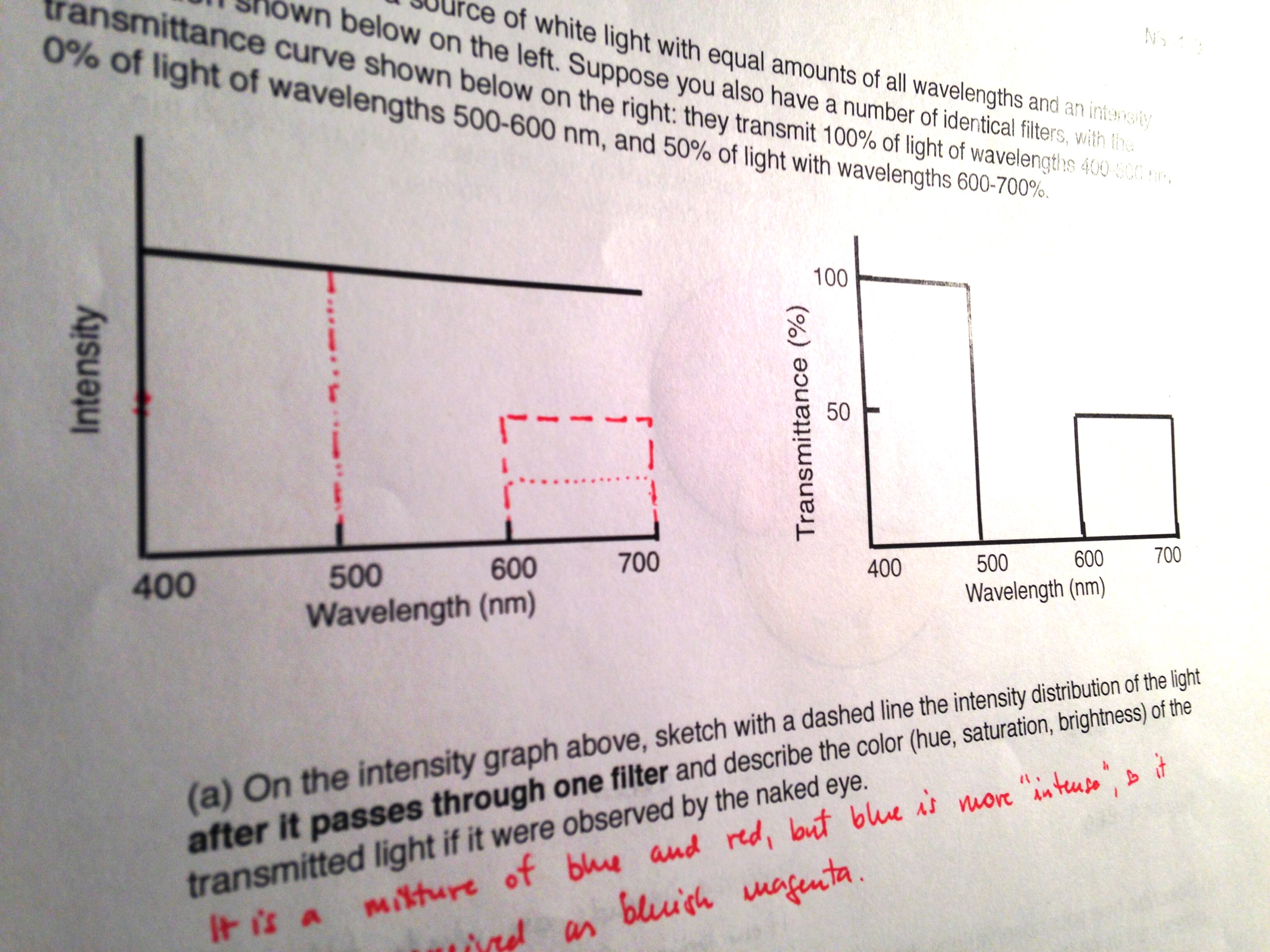
We worked on transmittance curves for multiple filters. - Looked at the real transmittance curves of our filters to understand why not all of the light is blocked by overlapping cyan, magenta, and yellow filters.
At the end, we went over all of the answers as a class.
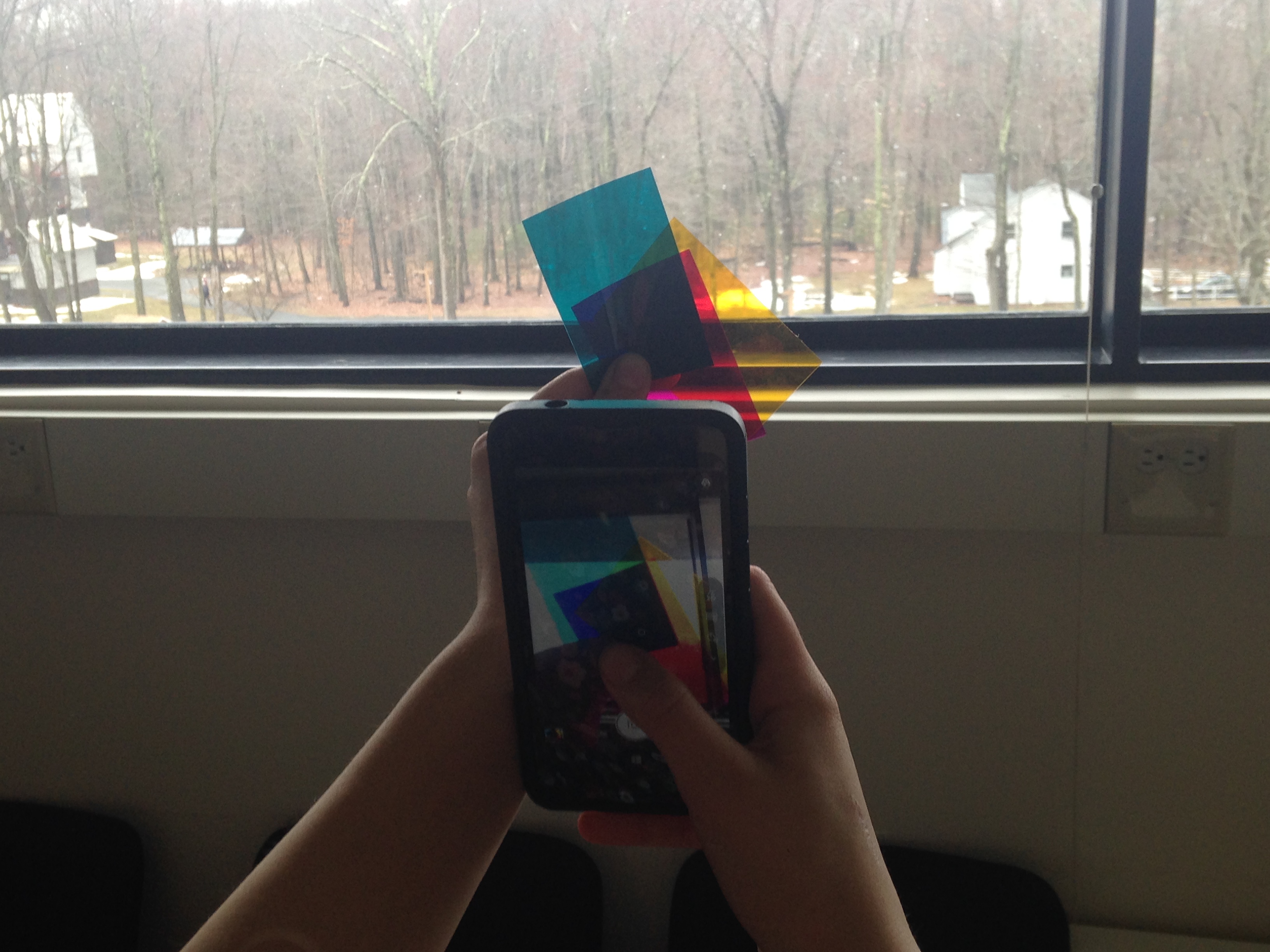
Subtractive mixing with filters. Materials:
-
Color Physics @Hampshire, Day 12
On day 12 we continued to talk about subtractive mixing with filters. We covered the following topics
- Subtractive mixing with filters
- Transmittance curves
- Ideal vs real fiters
- Cyan, Magenta, and Yellow (CMY) color system
- We also touched on color photography (and in particular the work of the physicist J. C. Maxwell) the early color films, including the two-color system and the three-color Technicolor system. We saw a nice example of early film created using the two-color system, for which the camera had rapidly changing red and green filters.
Other resources:
- An informal on-line resource on the use of subtractive color mixing in early film.
- Malcolm S Longair, “Maxwell and the science of color.” Phil. Trans. R. Soc. A 2008 366 1685-1696; DOI: 10.1098/rsta.2007.2178..Published 28 May 2008.
-
Color Physics @Hampshire, Day 11
Day 11 was more or less a rehash of the second half of Day 10, but in more depth and with more contact points with the visual arts.
The topics covered were:
- Infrared and ultraviolet photography.
- Metamers.
- Missing complementary pairs of spectral colors.
- Three types of additive color mixing and its applications:
- Direct addition of lights (TV monitors and projections on white surfaces in stage design).
- Partitive mixing and pointillism in painting (Seurat, Signac, and van Gogh).
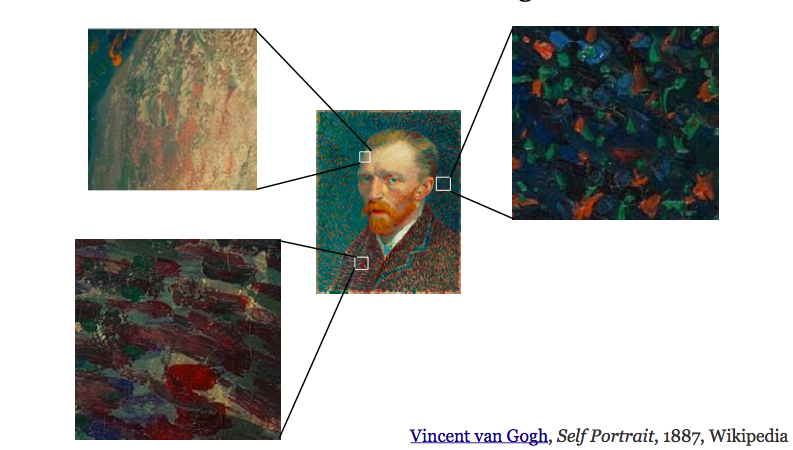
A self portrait of van Gogh’s as an example of the pointillist painting technique which relies on the principle of additive color mixing. - Mixing light “in time” with Newton’s disks, which students made for a homework assignment a few weeks ago.
Finally, we formally introduced subtractive mixing with filters and the transmittance graphs. Students then used diffraction gratings to break up the light from a tungsten lamp, observed which colors were absorbed by various filters, and sketched the transmittance graphs for those filters.
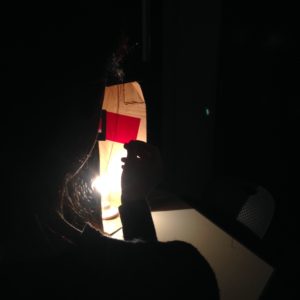
A student observing the color spectrum generated by a diffraction grating after the light has passed through a filter. Other interesting resources:
- Andrew Davidhazy, Overview of Infrared and Ultraviolet Photography, School of Photographic Arts and Sciences Rochester Institute of Technology. Accessed March 11, 2017.
- J. Kirby, K. Stonor, A. Roy, A. Burnstock, R. Grout and R. White. “Seurat’s Painting Practice: Theory, Development and Technology.” National Gallery Technical Bulletin, vol. 24, 2003.
- More pointillist painters on artsy.net
-
Color Physics @Hampshire, Day 10
After reviewing the concepts of wavelength, amplitude, and frequency in general, we discussed the special case of electromagnetic waves and the electromagnetic spectrum. The key ideas covered were the
- Inverse relation between the wavelength and frequency of an electromagnetic wave.
- Intensity of a wave and its relation to the amplitude of the wave.
In a lecture-heavy portion of the class, we went over how different properties of an EM wave in the visible spectrum correlate with the hue, saturation, and brightness of the perceived light. I used very good slides developed by Geoff Boynton at the University of Washington.
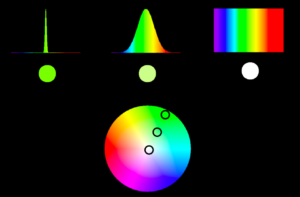
Geoff Boynton’s slide on the relation of the width of the spectral intensity-distribution of light and the perceived saturation. We introduced the spectral intensity-distribution graphs for light sources and the distinction between spectral colors and non-spectral colors, but also reviewed additive color mixing in the context of the intensity-distribution graphs. We touched on the relevance of additive mixing to the pointillist painting movement developed by Seurat.
Students then used hand-held spectrometers to determine the intensity-distribution for the red, green, and blue LED’s we used in additive mixing exercises earlier in the semester. We also tried to determine the spectrum of the mixture various pairs of lights. This was tricky because of the light pollution in the room and the fact that the light from two LED’s was coming from different angles and scattering within the spectrometer.
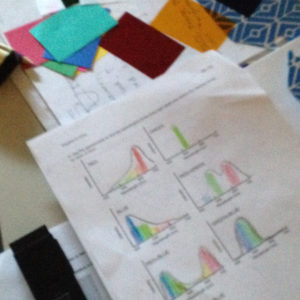 Students measured and recorded the intensity distributions of light from LEDs.
Students measured and recorded the intensity distributions of light from LEDs.
Some of the students got to start playing with color filters and explore their absorption spectrum, but more formal introduction was left for the following class.
-
Color Physics @Hampshire, Day 9
Day 9 was a continuation of our exploration of waves. The class time was divided into two main activities:
- Working in groups on conceptual exercises related to waves (drawing waves, ranking them based on various properties, etc.), led by me.
- Carrying out a more systematic study of waves on a slinky, which included quantitative measurements of the speed of a wave pulse, led by my colleague Fred Wirth who has offered to lend a helping hand this semester and who designed and coordinated this portion of the class.
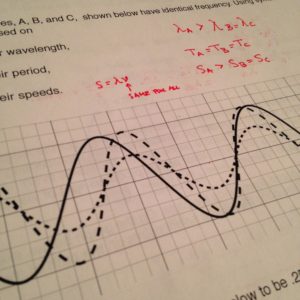
Conceptual Exercises on Waves At the end, we discussed as a class the solutions to some of the conceptual exercises.
-
Color Physics @Hampshire, Day 3
Topics
- Saturation, hue, and brightness
- Additive Color Mixing
We started Day 3 by playing with the HSB sliders on a computer software to determine which properties of perceived color are referred to as hue, saturation, and brightness.
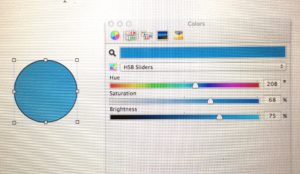
Playing with Hue, Saturation, and Brightness sliders to find out how they affect the color After using the hand-held spectrometers to investigate the spectrum of a computer screen, cellphone screens, and the video projector, students made predictions about how brightness, saturation, and hue may be affected by mixing different amounts of red, green, and blue light and tested their predictions using primary color light sticks.
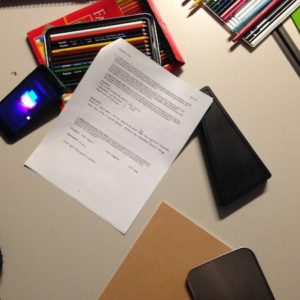
Making a prediction about color mixing and testing them. 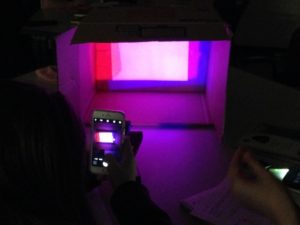
Mixing light with primary colors and investigating how digital images recored by a cellphone differ from what is seen by the naked eye. -
Physics of Color @Hampshire, Day 1:
Topic: Subjective experience of color, interaction of color, and afterimages.
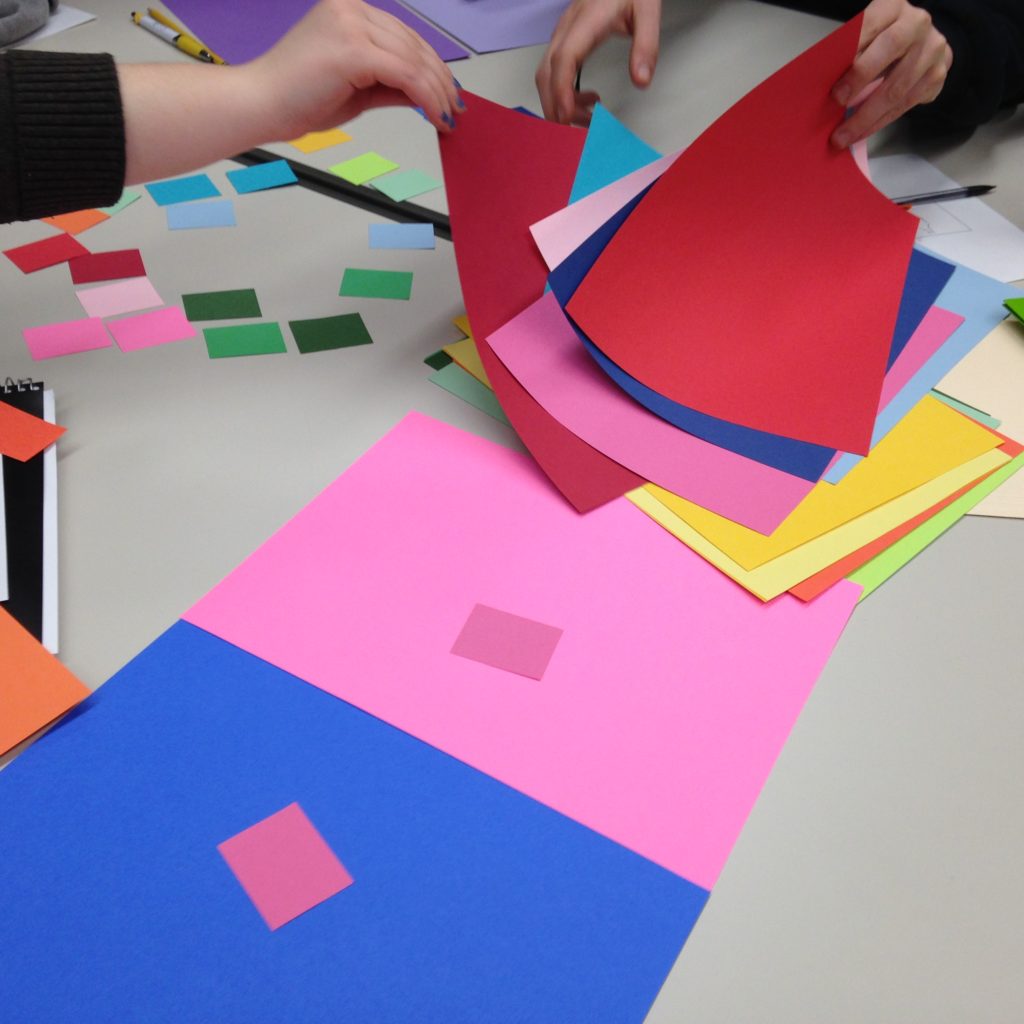
Experimenting with interaction of color. Today we looked at Josef Alber’s color plates, experimented with afterimages, talked about the dress, and created our own interaction of color compositions.
PDF’s of select slides are available here.
Other Resources:
-
Heaney’s Physics of Ironing
Poetic physics of Seamus Heaney. An excerpt form “The Smoothing Iron.”
Soft thumps on the ironing board.
Her dimpled angled elbow
and intent stoop
as she aimed the smoothing ironlike a plane into linen,
like the resentment of women.
To work, her dumb lunge says,
is to move a certain massthrough a certain distance,
is to pull your weight and feel
exact and equal to it.
Feel dragged upon. And buoyant.Heaney, Seamus. “The Smoothing Iron.” Opened Ground: Selected Poems 1966-1996. New York: Farrar, Straus and Giroux, 1999. Print.
-
Inertial Frames in Black and White
A 1960’s instructional video on inertial frames — a visual gem and an instructional piece of art.